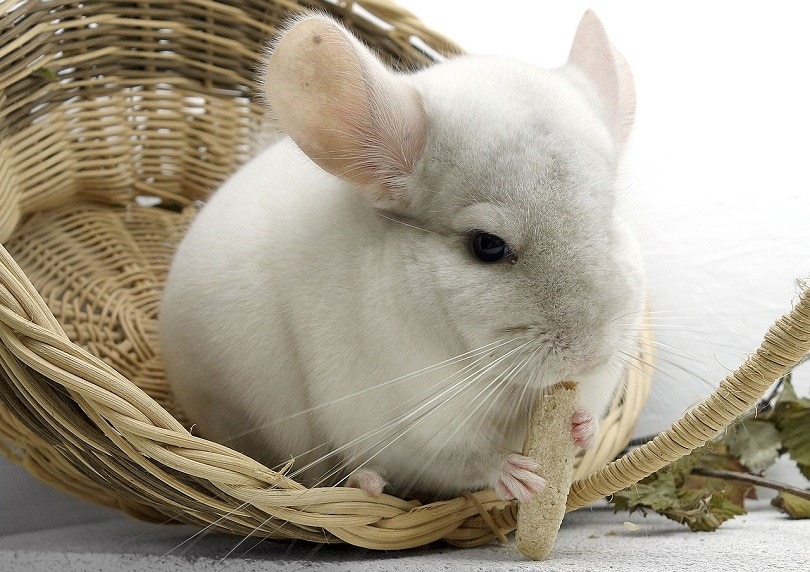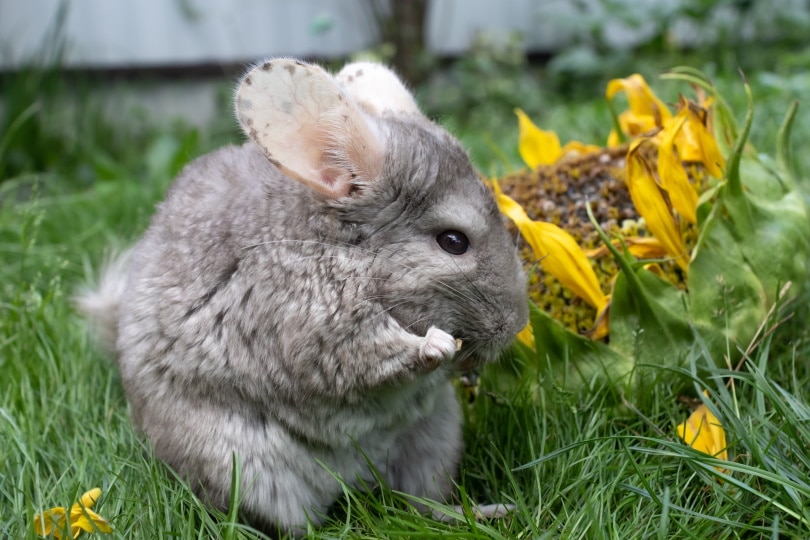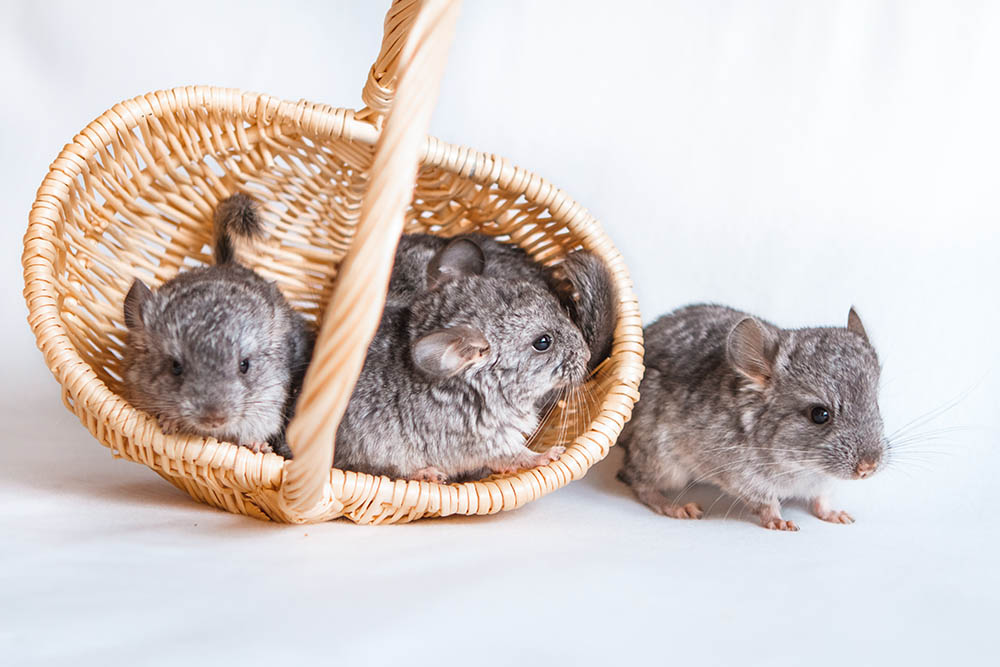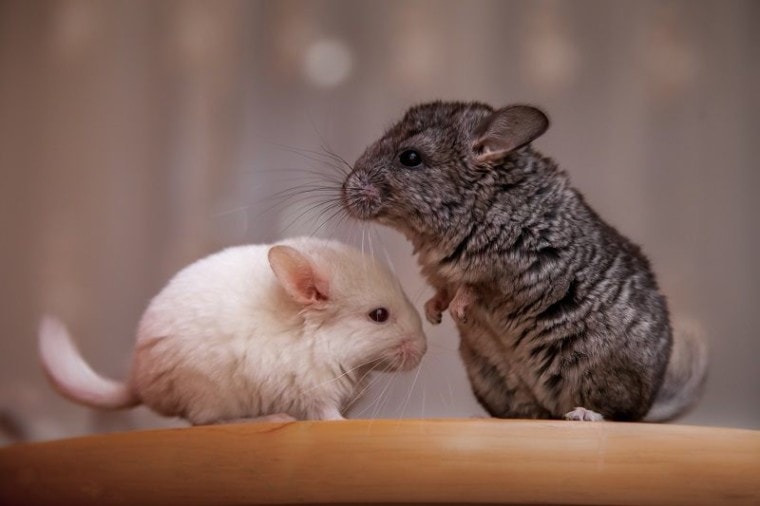
Chinchillas make terrific pets if you can provide them with enough space. They are active animals that are a joy to own. Like all pets, caring for a chinchilla involves understanding their needs. In this article, we’ll go over the most important care information for a chinchilla.
Chinchilla Facts
There are two species of chinchillas. In the wild, they live in the rock crevices of the Andes Mountains in Chile. The ones that you’ll find available for adoption as a pet are descendents of the long-tailed chinchilla (Chinchilla lanigera); in fact, all domestic chinchillas in the US are descendents of 13 descendents1 imported to the United States in 1927.
Both species of chinchillas are considered endangered in the wild. Their numbers in the wild have decreased drastically, largely due to human activity.
Chinchillas are relatively long-lived for a rodent, with an average lifespan exceeding 10 years. The native animals are a mottled gray-yellow, which provides excellent camouflage in the shrublands of the mountains. Selective breeding has opened up a broad spectrum of colors, from velvet to sapphire to dark blue-gray. In addition, selective breeding has led to three varieties in terms of body morphology as well: la plata, costina, and raton.
The chinchilla has a dense coat, with up to 80 hairs per follicle, more than any other land mammal! Their coat is what initially drew the interest from the fashion world, as they quickly gained popularity for their fur. Commercial chinchilla fur farms still exist in parts of the world; however, the use of chinchillas for their fur is widely viewed as controversial and unethical today.
Their coat influences their weather tolerance in two ways. First, they can tolerate the cold quite well. Second, high fur density means that chinchillas are humidity and heat sensitive. That’s something to bear in mind when setting up a cage for your new pet.
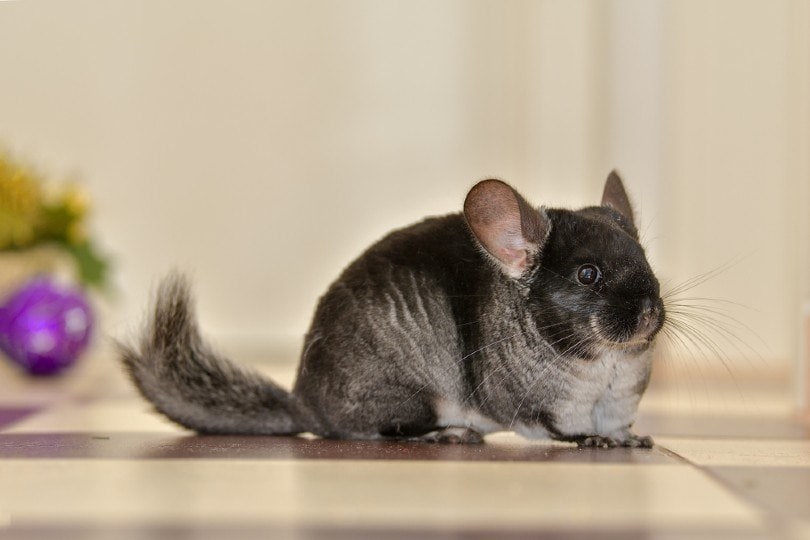
Fact Sheet & Care At a Glance
| Task | Frequency |
| Give fresh water | Every day |
| Remove uneaten or leftover food from the previous day | Every day |
| Give fresh food | Every day |
| Give fresh hay | Every day |
| Let out of cage for at least 2 hours for supervised exercise and play | Every day |
| Offer a short (10-20-minute) dust bath | Every day |
| Thoroughly clean food bowls and water bottles | Every other day |
| Consider offering a teaspoon of a safe treat (example: fruit) | Occasionally |
| Clean and disinfect the entire cage | Once a week |
| Check all appliances (thermometer, hygrometer) used their setup | Once a week |
| Weigh & perform a quick checkup to ensure pet is healthy | Once a week, or as instructed by your vet |
| Change bedding | As needed |
| Replace chew toys | As needed |
| Visit Your Vet | Shortly after adoption, and at a consistent schedule after that (as advised by your vet) |
Where Can I Get a Chinchilla?
Before figuring out where to adopt a chinchilla, it is important to first ensure that it is legal to own a chinchilla where you reside and that you have all their supplies ready (this includes a cage that is completely set up).
The best place to adopt a chinchilla would be via a reputable breeder or an adoption program that has been arranged by your local zoo or wildlife rescue center.
It is best to check reviews for the place you plan to adopt a pet from. Though chinchillas can be tamed, it is exceedingly more challenging to tame an adult that hasn’t been socialized well as a juvenile. Therefore, prior to adopting an individual, try to gauge the sociability and temperament of the other animals as well. Try to keep a close eye on the behavior of the animals as you approach, but be careful, as a startled animal may bite.
It’s also important to keep an eye for individuals that appear stressed, unwell, or malnourished, as this increases the risk of adopting an animal with underlying health issues.
It is best to adopt your pet from a source that offers a grace period in which you can have your newly adopted chinchilla checked for any potential health issues. Regardless of where you adopt your chinchilla from, it is very important to have them looked over by a veterinarian shortly after they’ve been adopted.
Owning a chinchilla is both a financial and time commitment. As with all pets, the initial investment into their setup is typically a very expensive endeavor.
What Kind of Home Does My Chinchilla Need?
Because chinchillas tend to be more active than some rodents, you’ll have to spring for a large, multi-level cage with ramps, perches, and platforms. Cages made of plastic-coated wire are not advised.
The size of the cage isn’t very important if your chinchilla is allowed out of their cage on a daily basis for exercise. However, it is still best to spring for the largest cage you can afford. Several cages are stackable if multiple units of the same cage are purchased. This is desirable for chinchillas, as they love to climb and jump around their enclosure.
Wire mesh cages can be used. If wire mesh is used, the grid on the sides of the cage should be no wider than 1 by 2 inches (25 by 50 millimeters). The openings on the bottom of cages with a wire bottom should be no wider than ½ by ½ inches (15 by 15 millimeters).
The advantage of a wire-bottom cage is that it allows droppings to go through to the tray below. However, it is important to note that your pet needs a solid area made from wood or hard plastic. This is to ensure that they don’t develop sore feet from standing on wire all the time.
An alternative is to clip the bottom of the cage with fleece. The downside to fleece is that it needs to be cleaned frequently, as chinchillas may indiscriminately urinate and defecate all over their cage. Therefore, several fleece cutouts of the same size might be required to ensure you always have a clean replacement for the bottom of your cage whenever necessary.
Chinchillas aren’t escape artists like some rodents are. As long as the cage door latches are secure, you shouldn’t have issues with a Houdini chinchilla.

Temperature & Humidity
Chinchillas have unique temperature requirements. They are prone to heat stroke at temperatures greater than 80°F (~27°C). They will also develop matted fur if kept in a warm, humid environment.
A chinchilla’s preferred temperature range indoors is 50 to 60°F (10 to 16°C). Their housing environment should be dry, free of drafts, moderately cool, and away from direct sun. They prefer a humidity level under or around 40%.
A good general rule is to add the unit values of the temperature (Fahrenheit) and humidity, and consider any value >150 to be dangerous. For example, 90°F + 60% humidity = 150, which means the environment is unsuitable for your pet.
Substrate
Bedding or a substrate is necessary to make your pet comfortable and provide an absorbent means to control odor and waste. We suggest avoiding aromatic products, which your chinchilla may find irritating. Instead, go with something unscented or, preferably, a recycled product for an eco-friendly solution. You should change it regularly for both yourself and your pet.
Food Bowls and Water Bottles
A shallow bowl is an excellent option for feeding your pet, considering the type of food that they eat. A water bottle is a better choice than a bowl to keep its bedding dry. Just make sure to get one that your chinchilla can’t chew through.
Hiding Places
We recommend adding at least one hiding place for your chinchilla. This will help your pet feel more secure in their home and also offer them a place to sleep during the day.

What Should I Feed My Chinchilla?
High-quality hay is an ideal food that serves several vital purposes. It contains the fiber your pet needs in their diet and should be a mainstay as far as their nutrition is concerned. It will also help wear down your pet’s teeth, which is something that you must consider with rodents.
Commercial pelleted diets formulated for chinchillas (available at most pet stores) provide nutrition as well but should always be supplemented with high-quality hay to ensure your pet gets enough fiber in their diet. The combination of hay and pellets should form the bulk of your pet’s diet.
There are commercial treats available that you can offer your pet. Treats should only be offered to your pet sparingly. Examples of other treats chinchillas can enjoy on occasion are:
Remember that, with all pets, it is best to consult your veterinarian to formulate a meal plan that works for your chinchilla. Each individual may have specific dietary needs based on their age, life stage, activity levels, and health status.
How Do I Take Care of My Chinchilla?
Chinchillas have some unique characteristics and requirements when it comes to their care.
Dust Baths
The density of their coats and the climate of their native habitat make dust baths the optimal way for chinchillas to stay clean. You should provide your pet with a pan filled with a dust bath for this purpose every day, for a period of around 10 to 20 minutes. Your pet will instinctively know what to do and roll around and play in it for several minutes. You should not let them bathe for excessive periods of time in a single sitting, as this can lead to health issues.
Exercise and Socialization
Exercise is vital for chinchillas. That’s one reason that we emphasize getting a larger cage. You can let your chinchilla outside of its cage to play — with two caveats. Their size is deceptive with all that fur. Make sure that the room is chinchilla-proof by blocking off any potential escape routes.
The other concern is their teeth. Chinchillas need and love to chew. That doesn’t stop when it comes to your furniture. If you let them out, make sure it’s supervised playtime.
Maintenance
Regular cage maintenance is imperative to provide a healthy environment for your pet. Daily spot cleaning will go a long way toward preventing bacterial and fungal infections. The entire cage should be thoroughly cleaned and disinfected at least once a week. You should also replace the bedding regularly or whenever it gets wet or soiled.
Routine Vet Care
Routine veterinary care is very important for chinchillas. Your vet can ensure that your pet is healthy and perform routine examinations (such as bloodwork, a fecal test, and a dental checkup) to ensure that your pet is thriving.
Depending on where you stay, your vet will recommend a schedule for regular welfare checkups. Generally speaking, these checkups are conducted once every 6 to 12 months.
Final Thoughts
Chinchillas can make delightful pets once you understand their environmental and dietary needs. They are sweet animals that are fun to watch and are relatively long-lived. That’s saying nothing about how cute and cuddly they are. We’re sure that you’ll never regret inviting one into your home.
As always, remember that your chinchilla requires routine veterinary care to ensure their quality of life is up to par and to diagnose and treat any ailments.
You may also want to read:
- Where to Buy a Chinchilla? (Plus Overview of the Best Places)
- When Do Chinchillas Sleep, & How Much Sleep Do They Need?
Featured Image Credit: Luniaka Maria, Shutterstock


